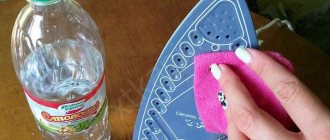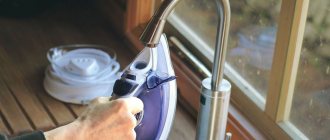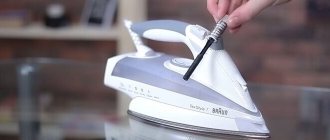Even owners of expensive household appliances sooner or later face the need to clean the iron from burnt fabric. Failure to comply with the temperature conditions leads to the fact that the fibers stick to the sole of the device and become charred. If you iron things with this iron in the future, brown spots will remain on the surface of your clothes and linen.
What types of irons are there and the specifics of cleaning them
To quickly and effectively clean the iron from burnt marks, you need to know what material the soleplate of the device is made of. This information can be found in the operating instructions.
With aluminum sole
These devices have one advantage - a high level of thermal conductivity. At the same time, aluminum irons have an affordable price. Aluminum is a soft material, so the base of the device is gradually covered with a large number of scratches.
It is not advisable to use abrasive substances and materials to clean the iron from the burnt iron on the aluminum soleplate. To do this, it is better to use more gentle means and methods.
With stainless steel sole
This coating is more durable than aluminum, but stainless steel ironing devices are now rare. You can also clean the soleplate of an iron made of this material using abrasives, carefully and forcefully treating the surface.
But housewives note that using such a device for ironing things is inconvenient. You need to iron clothes with this iron, placing gauze on it.
In addition, microdamages in the sole may contain contaminants that will be difficult to remove.
Iron with ceramic sole
These are durable and reliable models, but they must be used carefully. Do not use abrasives to clean your ceramic iron. It is better to use liquid products for this purpose.
A ceramic coating is more durable than Teflon. However, ceramic-based spraying wears off over time.
Teflon coated
Teflon is a brittle material. If fabric has stuck to an iron with a non-stick coating, or a coating has appeared, it is not advisable to use a knife to clean it, since the Teflon coating can be damaged in this case. It is better to use special cleaning pencils for this purpose, which are sold in any household chemical store.
In addition, if the Teflon coating is damaged, it will begin to rust, since underneath there is metal that is vulnerable to corrosion.
What can be used for different types of surfaces
Unsuccessful experiments in cleaning the outer surface of the iron can lead to the fact that the “assistant” in ironing things becomes unusable, so you need to carefully consider the best way to clean the soleplate of the iron from adhered synthetics and other contaminants.
For all types of irons, a universal tool is a pencil. Other products may not be suitable for cleaning the “delicate” surface of an electrical appliance. What is absolutely forbidden to do?
Prohibited:
- scrape off carbon deposits with sharp objects and leave scratches;
- rub the sole with a metal brush or sandpaper;
- rub, wash the iron when it is connected to the network.
Which irons can be cleaned in any way?
If an expensive Teflon-coated iron is burnt, it is better not to experiment with folk remedies. In such a situation, it is necessary to use a special cleaning agent. In addition, nothing bad will happen if the device is cleaned only after a few days.
To clean a burnt Soviet-made iron, which does not have special coatings or holes, you can use any means and methods.
Methods for coatings made of steel, titanium, enamel
Steel, titanium and enamel coatings are the most durable; they are not afraid of abrasives. All cleaning methods for ceramic and Teflon surfaces are also suitable for them. But there are also additional means.
Toothpaste
Regular toothpaste can remove burnt marks from an iron. You will also need an old toothbrush and cotton swabs.
Here's how to proceed:
- Apply the paste to areas with soot with a toothbrush.
- Connect the iron to the mains and heat to minimum temperature.
- Take a clean, damp sponge or rag and remove the paste. Turn off the device before doing this to avoid getting burned.
- Next, use cotton swabs to clean off any remaining paste if it gets into the steam outlet holes. You need to act quickly so that the mass does not have time to dry out.
- Wipe the sole with a clean cloth and iron the unnecessary cotton cloth at maximum temperature to make sure that no traces of paste remain.
Soda
Soda is a soft, gentle abrasive that will perfectly clean electrical appliances from burnt fabric. The following methods are quite effective:
- 2 tbsp. l. dilute soda with a small amount of water. Apply the resulting slurry to a cotton pad and wipe off the carbon deposits. There is no need to be afraid to press lightly on the sole; there will be no scratches.
- Combine 1 tsp. liquid dishwashing detergent, 1 tsp. soda and 1 tsp. water. Foam the total mass, spread over the sole and leave for 10-15 minutes. Then clean the surface with a hard sponge and rinse with water.
- 2-3 tbsp. l. soda powder diluted with a small amount of 3% peroxide. Apply this paste to the stains and remove with a clean cloth after 5-7 minutes.
After the procedure, wipe the iron dry.
Is it possible to get rid of melted synthetics?
Most often, this type of contamination appears as a result of ironing plastic elements on clothing. When thinking about how to clean synthetics, you should pay attention to special preparations that dissolve such substances and do not affect the coating of the iron.
From polyethylene
Nobody deliberately smoothes polyethylene. But sometimes molten particles of this material remain on the sole of the iron.
To prevent this problem, you should check each time at what temperature the device operates.
If there is already stuck synthetic material on the coating, you can use acetone. In addition, you can clean your iron from synthetic carbon deposits at home using nail polish remover.
You need to thoroughly saturate the bandage with the selected substance, and then treat the stains with it. After completing the procedure, the lower part of the iron should be moistened with water and wiped dry.
Pieces of synthetics can also be removed using ordinary laundry soap. To do this, you need to heat the device and rub the dirty areas, then leave the iron to cool. Then the product should be washed off with running water. Along with it, the remains of burnt synthetics will also be removed.
How to remove scale from inside?
We talked in detail about how to wipe the soleplate of the iron from the outside - you got acquainted with the available products for different types of dirt. It's time to discuss what and how to clean the inside of the iron at home from scale and sediment.
There are three proven means - you can choose what you want to use to clean the device:
- Vinegar;
- Mineral water;
- Citric acid.
To get rid of dirt on the inside, do the following:
- Prepare the solution;
- Pour it into the reservoir;
- Warm up the device to maximum temperature;
- Tilt the iron over any container and press the steam button;
- Wait for the liquid to come out and repeat the procedure 2-3 times, replacing the solution with boiled water.
As you can see, the principle of cleaning from the inside will be similar; you need to choose the correct proportions of the cleaning solution:
- Two teaspoons of citric acid per glass of water;
- Pure water and 9% vinegar solution in a 1 to 1 ratio.
We hope you don’t have any more questions - and if you do, learn a couple of little tricks that will help extend the life of the device and eliminate the need for constant cleaning.
How to clean an iron from burnt fabric?
You can clean the iron from burnt fabric in different ways. They must be selected taking into account the material, type and extent of contamination.
Special pencil
Pencil products allow you to quickly wipe off carbon deposits from your iron. They use ammonia as their active ingredient, so when using the pencils a specific smell arises.
These devices must be used according to the following scheme:
- First, the device warms up to the optimal temperature. The recommended value is indicated on the packaging of the product.
- Then the surface is carefully processed with a pencil. In this case, it is necessary to avoid getting the product into the steam vents. During the melting process, the pencil pieces will melt and slowly drain from the surface, taking with them the burnt layer and dirt. If there is burnt fabric on the coating, it is better to repeat the treatment 2-3 times so that the ammonia solution completely softens the material.
- At the final stage of processing, the iron must be cooled and any remaining product must be removed from it.
Salt
To clean your iron from carbon deposits using table salt, you need to take a handful of the product and place it on a cloth or paper sheet. In this case, it is better to choose finely ground salt.
Then the iron needs to be heated, and its sole should be passed over the scattered salt several times. The crystals will absorb soot particles into their structure and remove them from the coating. But when using this method, keep in mind that salt is an abrasive substance, so it can leave behind many small scratches.
After treatment, the cooled sole should be thoroughly wiped with a cloth. If the pollution does not recede, it is better to use another method.
Lemon acid
For this processing method, you need to prepare a solution of citric acid from 80 g of powder and 300 ml of slightly heated water.
Treat the contaminated surface with the prepared mixture and then wipe it dry.
Ammonia
In 1/2 cup of clean water you need to add 5-7 drops of concentrated ammonia, then mix the mixture thoroughly. Only cooled soles can be treated with this solution. For wiping, it is better to use natural fabric materials, since synthetics may react with the substance.
Hydroperite
Hydroperite tablets not only lighten hair, but also effectively combat carbon deposits on the soleplate of the iron.
However, it should be borne in mind that this substance has an aggressive effect, so budget models of ironing devices may become unusable after such treatment.
To clean, you need to dilute the tablets with water and bring the resulting mixture to a pasty state. The resulting mass should be applied to the contaminated surface. Then you need to warm up and cool the iron. Residues of the drug are wiped off with a clean cloth.
Why does carbon deposits appear on the iron?
The need to clean your iron from carbon deposits at home may arise for a number of different reasons. Even with the most careful handling, deposits periodically appear on the platform of the device, which, staining the laundry, reduces the quality of ironing.
The reason for this is burnt fabric, particles of which remain on the surface in the following cases of operation:
- The temperature range has been exceeded. At the same time, microfibers remain on the iron platform, which accumulate over a certain time and turn into carbon deposits.
- Using poor quality water. Limescale, which also forms in the iron, as in the kettle, makes the sole of the electrical appliance rough. At the same time, lint and fibers from clothing quickly clog the platform, forming a thin, barely noticeable coating. The quality of gliding is reduced. Carbon deposits form on the platform.
- An electrical appliance was accidentally left on the laundry. In this case, the fabric sticks to the sole, and further ironing becomes impossible. Burnt particles must be cleaned immediately.
- Damage to the platform. Any microcracks and scratches also affect the quality of ironing and are the main factor in the fact that burnt fibers and threads remain on the working platform.
- When ironing wool items, it is often overlooked that it is necessary to first cover such items with gauze, which is best left unwetted.
In order not to spoil a household appliance, you need to periodically remove the resulting contamination in the form of burnt fabric by carrying out preventive cleaning.
The best folk remedies for cleaning carbon deposits
You can also clean a burnt iron using home methods. At the same time, a different product is suitable for each type of coating. For example, it is better to clean metal with toothpaste, soda and paraffin; stainless steel, ceramics and Teflon - toothpaste and vinegar.
Paraffin candle
Using a piece of soft cloth and a paraffin candle, you can quickly remove carbon deposits from the soleplate of your iron with your own hands. In addition, this technique also helps remove minor scratches.
Processing should be carried out according to the following scheme:
- the paraffin candle must be wrapped in cotton cloth;
- then you need to thoroughly rub the heated coating with the product until the paraffin melts and removes the burnt fabric.
This method must be used with extreme caution, since the heated paraffin mixture can cause burns or enter the device through the steam outlet holes. If paraffin particles flow inside the device, you can remove them by ironing a piece of cloth or paper sheet in the steaming mode.
Toothpaste and soda
Teeth cleaning paste can remove carbon deposits from almost any surface. But when using this product, you should take into account that it contains abrasive particles that can damage the sole if processed too frequently.
The paste should be used as follows:
- the sole is heated, after which paste is applied to it;
- the product is thoroughly rubbed with a brush;
- then the surface is washed with running water and wiped dry with a soft cloth.
To clean the steam vents, you can use ordinary cotton swabs.
Another effective folk method for cleaning an iron is baking soda. Apply a composition based on water and soda to the soleplate of the iron that is turned off. After 20 minutes, the mixture is wiped off the surface with a soft cloth.
With the help of baking soda and toothpaste, you can even get rid of old stains and stuck-on synthetic particles. But these substances will cause microcracks and scratches on the coating. Therefore, they should be used only in extreme cases, when other methods have failed to solve the problem.
Table vinegar
Acetic acid should be used in a room with good ventilation, since the fumes of this substance can cause discomfort and intoxication.
For processing you need to adhere to the following scheme:
- vinegar concentrate is diluted with water in a ratio of 1 to 1;
- a cotton cloth is moistened in the prepared solution, after which the heated sole is wiped with it;
- for ceramic-based coatings, you can add 4-6 drops of hydrogen peroxide to the solution. The substance will whiten the metal surface and return it to its former shine.
You can mix vinegar with ammonia and lemon juice. This home remedy will quickly and efficiently remove any carbon deposits.
Hydrogen peroxide
This folk remedy has proven itself to be effective in removing various contaminants. To process, you need to soak a cotton pad or ball in the solution, and then carefully treat the surface with it.
You can try to remove old carbon deposits with a solid form of peroxide - hydroperite. To do this, you just need to rub the surface with a hydroperite tablet and heat the sole. After cooling, the remnants of the drug are removed with a damp cloth, after which the surface is wiped dry.
When using this method indoors, all windows must be opened. The soleplate of the iron must be heated to maximum temperature before applying the substance.
Soap
Laundry soap is an effective and safe way to remove fresh carbon deposits. This product is not suitable for old stains because it does not have a sufficiently aggressive effect.
The surface of the iron needs to be heated, then rubbed with a bar of soap and left to cool completely. Contaminants are removed with a damp cloth.
You can also soak the fabric in the soap mixture and iron it with a heated sole. Holes in the coating should be cleaned with a toothpick or cotton swab.
To prevent the appearance of streaks, after using the device, you need to iron it with clean, moistened gauze.
Clean with salt and newspaper
Another simple way to clean the soleplate of your iron is with newspaper and salt. But keep in mind that in no case should you clean the Teflon and non-stick coating in this way. They do not tolerate abrasive substances.
First you need to heat the device to maximum temperature, and then turn on the steam function. While it is heating up, take a minute to lay out a sheet of newspaper and sprinkle generously with salt. Run a hot iron over the salted newspaper until the sediment and stains disappear.
Method 7: Salt
If we are talking about an iron with a metal coating, table salt will come to the rescue. It is enough to pour salt onto thick paper and iron it with a hot iron. Once the carbon deposits are gone, wipe the surface with a damp cloth after it has cooled. You can also do a more gentle method if you are afraid of scratching the surface. Fold the gauze in half, pour salt crystals into the middle and iron until the result is achieved.
We hope the article was useful. Thanks for reading!
Salt
Method 1: Cleaning Pencil
This method is suitable for cleaning irons that have a sole with a ceramic or Teflon surface. The pencil is sold in hardware stores and contains acids and ammonia. The device is cleaned when it is turned on, when it reaches a temperature of 200 degrees. Wipe the sole with a pencil so that the product does not flow into the steam holes, otherwise it will cause blockage and lead to breakdown. The dark mark left by the pencil can be removed by stroking a clean fleecy cloth.
Cleaning Pencil











